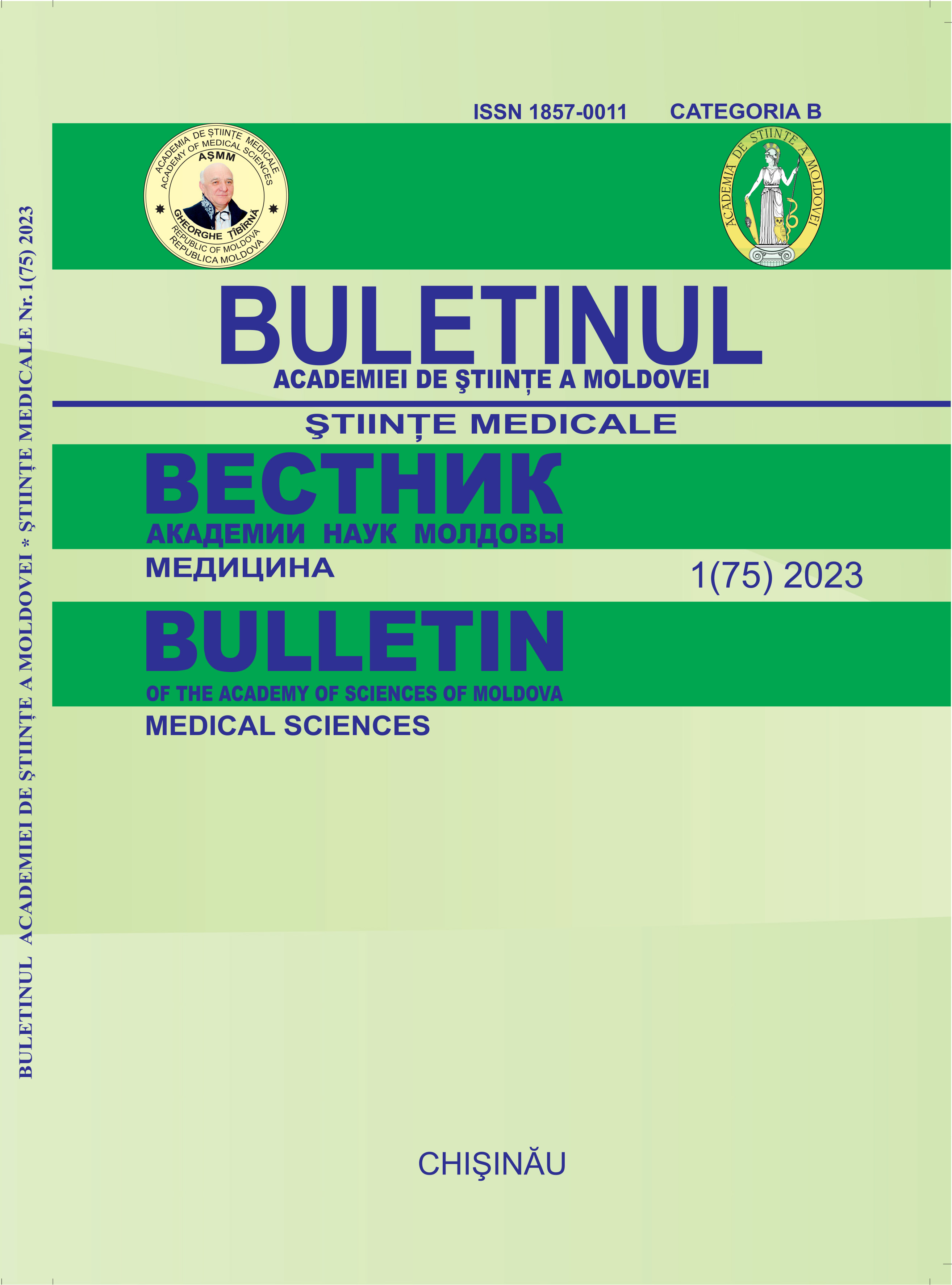Diagnostic approach of orthostatic arterial hypertension
DOI:
https://doi.org/10.52692/1857-0011.2023.1-75.20Keywords:
orthostatic hypertension, treatment, risk factorsAbstract
The first references regarding the term arterial orthostatic hypertension, which means the elevation of blood pressure values, when passing from clinoto orthostatism, date from the beginning of the 1940s [1]. Currently, there is no any consensus regarding the term orthostatic arterial hypertension, and there are few reports and studies on this subject, compared to orthostatic arterial hypotension, although both pathologies are assumed to be based on a common physiopathological mechanism - dysfunction of the autonomic nervous system. Because the definition of OHT differs from one study to another, the development of a consensus is problematic. Specific recommendations regarding the treatment of orthostatic arterial hypertension have not been drawn up, as the evidence regarding the treatment of this patology is based only on limited non-randomized studies. The aim of this article is to systematize data from the literature regarding the definition, establishment of diagnosis and pathophysiological of orthostatic hypertension.
References
Mccann WS, Romansky MJ. Orthostatic hypertension: the effect of nephroptosis on the renal blood flow. JAMA. 1940;115:573–578.
Fessel J, Robertson D. Orthostatic hypertension: when pressor reflexes overcompensate. Nat Clin Pract Nephrol. 2006;2(8):424‐431.
Townsend RR, Chang TI, Cohen DL, et al. Orthostatic changes in systolic blood pressure among SPRINT participants at baseline. J Am Soc Hypertens. 2016;10(11):847‐856.
Suemoto CK, Baena CP, Mill JG, Santos IS, Lotufo PA, Benseñor I. Orthostatic hypotension and cognitive function: cross‐sectional results from the ELSA‐Brasil study. J Gerontol A Biol Sci Med Sci. 10.1093/gerona/ gly061.
Bhuachalla BN, McGarrigle CA, O’Leary N, et al. Orthostatic hypertension as a risk factor for age‐related macular degeneration: evidence from the Irish longitudinal study on ageing. Exp Gerontol. 2018;106:80‐87.
Yoshinari M, Wakisaka M, Nakamura U, Yoshioka M, Uchizono Y, Iwase M. Orthostatic hypertension in patients with type 2 diabetes. Diabetes Care. 2001;24(10):1783‐1786.
Streeten DH, Auchincloss JH Jr, Anderson GH Jr, Richardson RL, Thomas FD, Miller JW. Orthostatic hypertension. Pathogenetic studies. Hypertension. 1985;7(2):196‐203.
Moreno Velásquez, I., Pischon, T. Comment to the article: “Consensus statement on the definition of orthostatic hypertension endorsed by the American Autonomic Society and the Japanese Society of Hypertension” by Jordan and colleagues. Clin Auton Res (2022).
Kario K. Orthostatic hypertension – a new haemodynamic cardiovascular risk factor. Nat Rev Nephrol. 2013;9(12):726‐738.
Brignole M, Moya A, de Lange FJ, et al. 2018 ESC Guidelines for the diagnosis and management of syncope. Eur Heart J. 2018;39(21):1883‐1948.
Robertson D. Orthostatic hypertension: the last hemodynamic frontier. Hypertension. 2011;57(2):158‐159.
Ricci F, De Caterina R, Fedorowski A. Orthostatic hypotension: epidemiology, prognosis, and treatment. J Am Coll Cardiol. 2015;66(7):848‐860.
Agnoletti D, Valbusa F, Labat C, et al. Evidence for a prognostic role of orthostatic hypertension on survival in a very old institutionalized population. Hypertension. 2016;67(1):191‐196.
Lee H, Kim HA. Orthostatic hypertension: an underestimated cause of orthostatic intolerance. Clin Neurophysiol. 2016;127(4):2102‐2107
Wijkman M, Länne T, Östgren CJ, Nystrom FH. Diastolic orthostatic hypertension and cardiovascular prognosis in type 2 diabetes: a prospective cohort study. Cardiovasc Diabetol. 2016;15:83.
Hoshide S, Kario K, Eguchi K, Ishikawa J, Morinari M, Shimada K. Altered aortic properties in elderly orthostatic hypertension. Hypertens Res. 2005;28(1):15‐19.
Vriz O, Soon G, Lu H, Weder AB, Canali C, Palatini P. Does orthostatic testing have any role in the evaluation of the young subject with mild hypertension?: an insight from the HARVEST study. Am J Hypertens. 1997;10(5 Pt 1):546‐551.
Buddineni JP, Chauhan L, Ahsan ST, Whaley‐ Connell A. An emerging role for understanding orthostatic hypertension in the cardiorenal syndrome. Cardiorenal Med. 2011;1(2):113‐122.
Kario K, Eguchi K, Hoshide S, et al. U‐curve relationship between orthostatic blood pressure change and silent cerebrovascular disease in elderly hypertensives: orthostatic hypertension as a new cardiovascular risk factor. J Am Coll Cardiol. 2002;40(1):133‐141.
J Clin Hypertens (Greenwich). 2019 Mar; 21(3): 426–433.
Benarroch EE. Postural tachycardia syndrome: a heterogeneous and multifactorial disorder. Mayo Clin Proc. 2012;87(12):1214‐1225.
Low PA, Sandroni P, Joyner M, Shen WK. Postural tachycardia syndrome (POTS). J Cardiovasc Electrophysiol. 2009;20(3):352‐358.
Downloads
Published
License
Copyright (c) 2023 Bulletin of the Academy of Sciences of Moldova. Medical Sciences

This work is licensed under a Creative Commons Attribution 4.0 International License.



